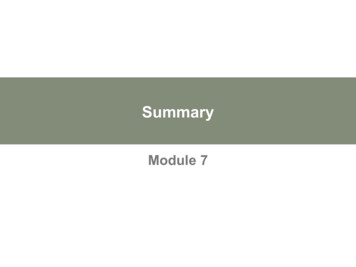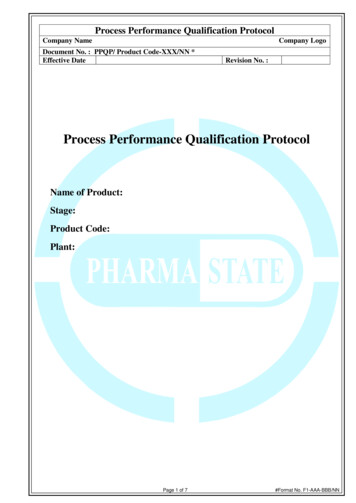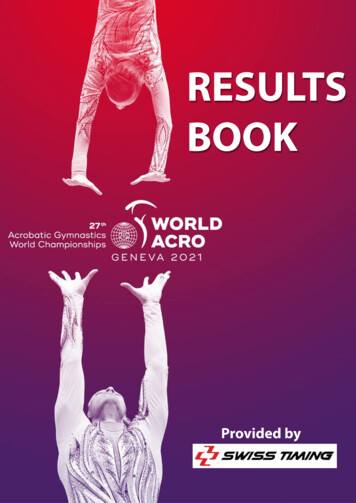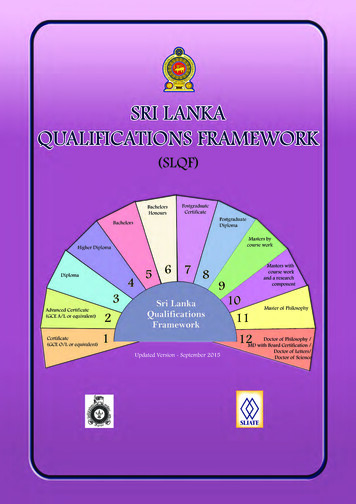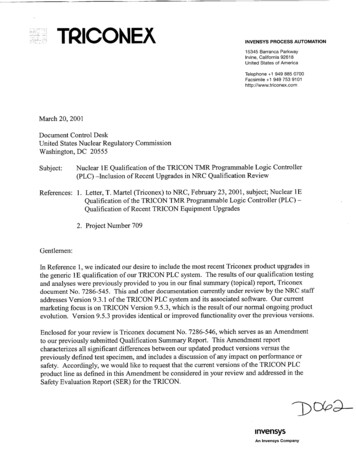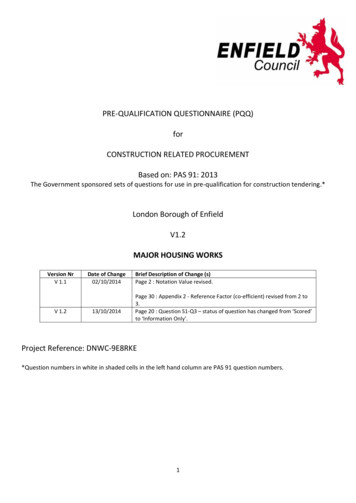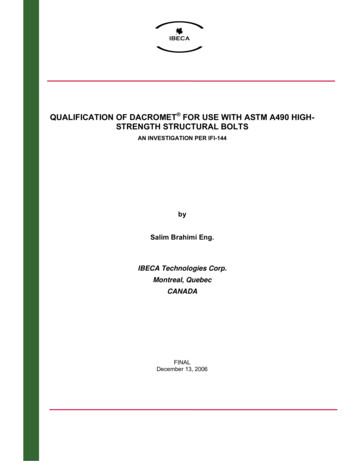
Transcription
IBECAQUALIFICATION OF DACROMET FOR USE WITH ASTM A490 HIGHSTRENGTH STRUCTURAL BOLTSAN INVESTIGATION PER IFI-144bySalim Brahimi Eng.IBECA Technologies Corp.Montreal, QuebecCANADAFINALDecember 13, 2006
IFI-144 Qualification of DACROMET IBECA Technologies - December, 2006EXECUTIVE SUMMARYASTM A490 currently prohibits the application of metallic coatings on its highstrength structural bolts. At the heart of this prohibition was the desire to institute ameasure that would eliminate the risk of hydrogen embrittlement. The long termobjective of this investigation was to make a case for allowing the application of a“safe” metallic coating on high strength structural fasteners. To achieve this, themethodology prescribed in IFI-144 was applied to qualify the DACROMET coatingsystem for use with ASTM A490 bolts. DACROMET satisfied all of theperformance criteria specified in IFI-144, including paintability, coating adhesion,and rotational capacity. Continuous salt spray and cyclic exposure demonstratedthat DACROMET has significantly superior corrosion protection capabilities incomparison with hot dip galvanizing and mechanical galvanizing. Processqualification results and product testing results demonstrated that DACROMET does not cause internal hydrogen embrittlement (IHE), nor does it promoteenvironmental hydrogen embrittlement (EHE) when used on ASTM A490 bolts.Finally, the investigation demonstrated that IFI-144 can serve as an effective testingroadmap for qualifying metallic coatings for use with high strength structuralfasteners.This report is primarily intended for review by ASTM Committee F16 on Fastenersand the Research Council on Structural Connections (RCSC), with the aim ofproviding the necessary data for both bodies to (i) consider approving DACROMET for use on ASTM A490 high strength structural bolts, and (ii) endorse IFI-144 as abasis for qualifying metallic coatings for use with high strength structural fasteners.-2-
IFI-144 Qualification of DACROMET IBECA Technologies - December, 2006CONTENTS1.INTRODUCTION . 52.THEORETICAL BACKGROUND. 62.1 HYDROGEN EMBRITTLEMENT – BRIEF REVIEW . 62.2 COATING PROCESSES . 72.2.1DACROMET Coating System. 72.2.2Hot-Dip Galvanizing . 82.2.3Mechanical Galvanizing. 83.EXPERIMENTAL PROCEDURE. 93.1 HARDWARE. 93.1.1Test Bolts . 93.1.2Nuts and Washers. 103.1.3Fixtures. 103.2 EXPERIMENTAL SETUP . 103.3 TEST METHODS FOR IFI-144 QUALIFICATION . 113.4 APPLICATION OF COATINGS . 123.4.1DACROMET . 123.4.2Hot-Dip Galvanizing . 133.4.3Mechanical Galvanizing. 143.5 SAMPLING PLAN. 154.RESULTS AND DISUSSION . 174.1 HARDNESS. 174.2 CHEMICAL ANALYSIS . 184.3 MICROSTRUCTURE . 194.4 COATING THICKNESS. 204.5 PAINTABILITY. 214.6 ADHESION TEST. 234.7 ROTATIONAL CAPACITY. 244.8 SALT SPRAY EXPOSURE. 254.9 CYCLIC EXPOSURE . 274.10TENSILE STRENGTH . 31-3-
IFI-144 Qualification of DACROMET 5.IBECA Technologies - December, 20064.11HYDROGEN EMBRITTLEMENT – PRODUCT TESTING . 324.12FRACTOGRAPHY . 354.13HYDROGEN EMBRITTLEMENT – PROCESS QUALIFICATION . 36SYNOPSIS . 405.1 COATING CHARATERISTICS . 405.2 CORROSION PERFORMANCE. 415.3 HYDROGEN EMBRITTLEMENT. 416.CONCLUSIONS . 44AKNOWLEDGEMENTS . 45REFERENCES. 46REFERENCED STANDARDS . 47APPENDICES . 48APPENDIX A: HOT DIP GALVANIZING . 49APPENDIX B: MECHANICAL GALVANIZING . 51APPENDIX C: HARDNESS - BOLTS. 52APPENDIX D: HARDNESS - NOTCHED SQUARE BARS . 54APPENDIX E: COATING THICKNESS - BOLTS . 55APPENDIX F: COATING THICKNESS - NOTCHED SQUARE BARS. 58APPENDIX G: PAINTABILITY . 61APPENDIX H: ADHESION. 62APPENDIX I: ROTATIONAL CAPACITY . 63APPENDIX J: CONTINUOUS SALT SPRAY . 64APPENDIX K: CYCLIC TESTING . 65APPENDIX L: TENSILE STRENGTH. 68APPENDIX M: HYDROGEN EMBRITTLEMENT TESTING. 69APPENDIX N: PROCESS QUALIFICATION. 70-4-
IFI-144 Qualification of DACROMET 1.IBECA Technologies - December, 2006INTRODUCTIONIn May of 2000, the Industrial Fasteners Institute (IFI) issued a standard guidenamed IFI-144, “Test Evaluation Procedures for Coating Qualification Intended forUse on High-Strength Structural Bolts.” IFI-144 was designed to serve as acomprehensive testing and validation methodology to qualify metallic coatings foruse on high strength structural fasteners, namely ASTM A490 bolts which arecharacterized by a tensile strength ranging from 150,000 psi to 173,000 psi. TheASTM A490 standard currently prohibits the application of metallic coatings. Thisprohibition was primarily intended for hot dip zinc, but also includes mechanicaldeposition, or electroplating of zinc or any other metallic coating. ASTM A490 citesTownsend (Ref. 1), who in 1975 published a study on the risks posed by zinccoatings on stress corrosion cracking and hydrogen embrittlement of low alloy steel.With the advent of new coating processes and processing technologies, thebroadness of the prohibition is being questioned. Common arguments in favor ofrevisiting the topic are that galvanizing of class 10.9 structural bolts is a standardpractice in Europe, and that there is a need in the market for coated A490 bolts. Thetesting requirements set forth by IFI-144 are designed to first assess if a coating orcoating process increases the risk of hydrogen embrittlement failure, while alsoensuring the coating’s capability to satisfy a comprehensive set of performancecriteria such as corrosion resistance, rotational capacity, coating adhesion, andpaintability.The main objective of this investigation was to apply the methodology prescribed inIFI-144 to perform an evaluation of DACROMET on ASTM A490 bolting, with somecomparisons to hot dip galvanizing and mechanical galvanizing.-5-
IFI-144 Qualification of DACROMET IBECA Technologies - December, 20062.THEORETICAL BACKGROUND2.1HYDROGEN EMBRITTLEMENT – BRIEF REVIEWHigh strength threaded steel fasteners are broadly characterized by tensilestrengths of 150,000 psi and greater. High tensile bolts are often used in criticalapplications such as bridges, vehicle engines, aircraft and ships. The prevention ofhydrogen embrittlement (HE) in these components is a fundamental design andapplications consideration. Hydrogen embrittlement is divided into two broadcategories based on the source of hydrogen.Internal Hydrogen Embrittlement (IHE) – also termed slow strain rateembrittlement and delayed failure; it is caused by residual hydrogen fromprocessing steps such as melting and pickling or from coating processes such aselectroplating. This is a particular concern with the coating of high strength steelcomponents, especially fasteners. Consequently a great deal of attention has beenpaid to IHE phenomena. The delayed nature of this type of hydrogen embrittlementsuggests that it is controlled by the trapping mechanism and the diffusion ofhydrogen within the matrix. IHE is usually reversible, meaning that ductility can berestored provided microcracks have not been initiated and the traps are notcharacterized by a high bonding energy.Environmental Hydrogen Embrittlement (EHE) – is caused by hydrogenintroduced into steel from external sources. Stress Corrosion Cracking (SCC) is asubset of EHE, and is characterized by corrosion-produced hydrogen beingabsorbed into steel under applied stress. Other external sources of hydrogen, suchas high pressure hydrogen gas or hydrogen sulphide gas can also cause EHE.Most forms of EHE are not reversible because they occur in the presence of stress,resulting in the initiation of microcracks.For fasteners that have a metallic coating for corrosion protection, SCC failures canbe significantly accelerated by a phenomenon known as Cathodic HydrogenAbsorption (CHA). As a general guideline, coatings are selected such that they areanodic with respect to the substrate. A typical example is a zinc coated bolt. If thecoating becomes damaged, say on installation or during manipulation, and it isexposed to a corrosive aqueous environment, a galvanic couple is created betweenthe coating and the substrate. The coating is designed to sacrificially corrode toprotect the steel bolt from rusting. Normally this intended sacrificial effect is a goodthing. However theoretically, the reduction process on the exposed steel surfacesimultaneously results in the evolution of hydrogen. The quantity of hydrogen beinggenerated increases for coatings with greater corrosion potentials (more sacrificial).In the case of very susceptible and highly stressed materials, this phenomenon willcreate an in-situ service condition that increases the risk of hydrogen embrittlementfailure.-6-
IFI-144 Qualification of DACROMET IBECA Technologies - December, 2006A number of factors affect the behavior of steels exposed to hydrogen and thereforetheir susceptibility to hydrogen embrittlement. The most significant are hydrogenconcentration, applied or residual stress, microstructure and temperature.Hydrogen Concentration – the first notion to consider is that of a criticalconcentration of hydrogen leading to fracture at a given stress. Below this criticalconcentration fracture will not occur, regardless of the applied stress.Threshold Stress – is the second notion to consider. Threshold stress for the onsetof hydrogen assisted cracking is defined as the applied stress below which no timedependant cracking will occur regardless of hydrogen concentration, but abovewhich subcritical cracking will lead to time delay fracture. Therefore whenconsidering hydrogen embrittlement, the threshold stress separates
The ASTM A490 standard currently prohibits the application of metallic coatings. This prohibition was primarily intended for hot dip zinc, but also includes mechanical deposition, or electroplating of zinc or any other metallic coating.File Size: 2MBPage Count: 71

